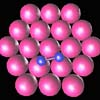| . |  |
. |
Spider silks could become the intelligent materials of the future, according to a review article published this month in the journal Microbial Cell Factories. The characteristics of spider silk could have applications in areas ranging from medicine to ballistics. The distinctive toughness of spider silk could allow manufacturers to improve wound-closure systems and plasters, and to produce artificial ligaments and tendons for durable surgical implants. The silk could also be woven into strong textiles to make parachutes, body armour, ropes and fishing nets. A whole range of ecological materials could emerge from the industrial production of spider silk. Thomas Scheibel, from the Department of Chemistry of the Technische Universitat in Munchen explains that there are currently over 34,000 described species of spider, each with a specific tool-kit of silks with different mechanical properties serving specific purposes. For example, major ampullate silk, a very tough silk with a tensile strength comparable to Kevlar, is used for the primary dragline or scaffolding of the spider's web. Minor ampullate silk with its very low elasticity is used to reinforce the web, while the strong and stretchy flagelliform silk forms the capture spiral of the web. Biotechnologists are currently analysing the properties of silk proteins and how they assemble into threads. Knowing exactly how silk fibers are formed and what mechanical properties result from different assembly processes could allow the manufacture of artificial spider silks with special characteristics such as great strength or biochemical activity. "The future objective might not be to prepare identical copies of natural silk fibers, but rather to capture key structural and functional features in designs that could be useful for engineering applications" explains the author. Spiders are territorial and cannibalistic and so impossible to farm. The only way to produce large quantities of silk is to engineer and insert silk genes into other cells or organisms. But this has been complicated by the nature of the genes, which include many repeated sequences and rely on a different codon reading system from ours. However, in recent studies parts of the genes were successfully inserted into the bacterium E. coli, mammal and insect cells, which in turn produced silk proteins. "Using 'protein engineering' based on knowledge achieved from investigations of the natural silks, artificial proteins can be designed that allow bacterial synthesis at high yields" writes Scheibel in the article*. Engineering new proteins would also allow the design of completely new types of silk fiber, which could assemble with biochemically or biologically active groups into new types of mesh. These 'intelligent' materials would then be able to carry out enzymatic reactions, chemical catalysis or electronic signal propagation, for example. Before this can be achieved, the spinning of proteins into fibers has to be resolved. So far there have been a few attempts at spinning silk on silicon micro-spinnerets. The outcomes have been promising but are far from matching naturally produced silks. For the moment the fibers produced are too wide, with diameters ranging from 10 to 60mm, compared with diameters of 2.5 to 4.0mm in natural fibers. Related Links Technische Universitat Munchen SpaceDaily Search SpaceDaily Subscribe To SpaceDaily Express  Atlanta GA (SPX) Nov 26, 2004
Atlanta GA (SPX) Nov 26, 2004For the first time ever, Emory University researchers have broken through the so-called "oxo-wall" to create stable multiple chemical bonds between oxygen and platinum � once thought impossible because oxygen is extremely unstable when combined with certain metals.
|
| ||||||||||
| The content herein, unless otherwise known to be public domain, are Copyright 1995-2016 - Space Media Network. All websites are published in Australia and are solely subject to Australian law and governed by Fair Use principals for news reporting and research purposes. AFP, UPI and IANS news wire stories are copyright Agence France-Presse, United Press International and Indo-Asia News Service. ESA news reports are copyright European Space Agency. All NASA sourced material is public domain. Additional copyrights may apply in whole or part to other bona fide parties. Advertising does not imply endorsement, agreement or approval of any opinions, statements or information provided by Space Media Network on any Web page published or hosted by Space Media Network. Privacy Statement All images and articles appearing on Space Media Network have been edited or digitally altered in some way. Any requests to remove copyright material will be acted upon in a timely and appropriate manner. Any attempt to extort money from Space Media Network will be ignored and reported to Australian Law Enforcement Agencies as a potential case of financial fraud involving the use of a telephonic carriage device or postal service. |